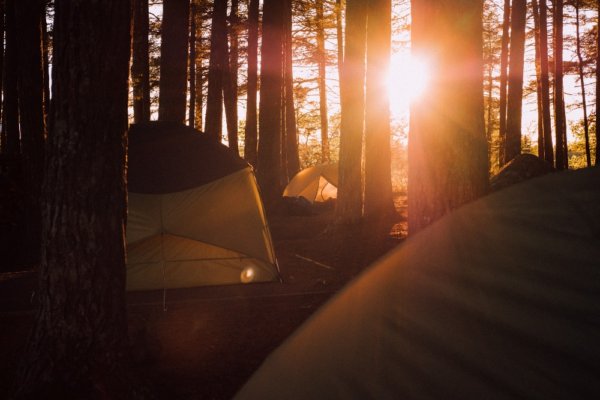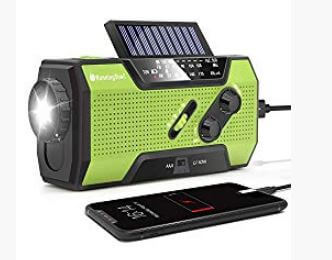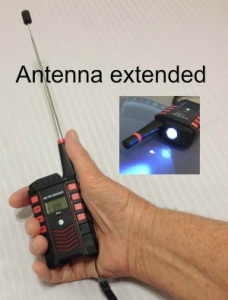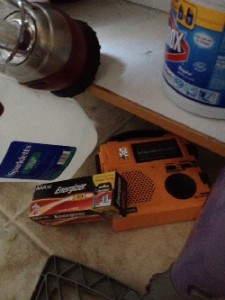Top 10 List of Emergency Preparedness Items
Back to the Basics – Updated 11-2022

At least once a year, we try to quickly go over the top 10 items that belong in every survival kit. If you have a basic pack in the car, one in the office, and one in the house FOR EACH FAMILY MEMBER, you can breathe a lot easier when someone asks, “Are you really prepared for an emergency?”
Here’s this year’s basic top 10 list, with some suggestions about how many of each item to get, where to get them and what they might cost. You’ll notice that the list categories stay pretty much the same, but a new item is added from time to time, and our top recommendations change as new products become available.
New items for 2022 have pictures and prices shown below.
As always, if you click on the product links, you’ll go over to Amazon, where you can shop for just what you want and likely get the best possible price, too. And as we’ve explained, Emergency Plan Guide may get a small commission on the sale — a commission that doesn’t affect your price.
You don’t have to do it all at once!
If you’re just starting to put together your survival kits, consider doing the research and getting just 2 or 3 items a week. Some of them you may already have — they just need to be assembled in one place. Or, build a list and shop at Amazon and have everything within a couple of days. (Black Friday specials may save a lot of money!)
We’ve added these symbols – 〈〉 – so you can check off each item as you get it!
〈〉 1 – Water
This has to be first on your top 10 list of emergency preparedness items. If you can grab a bottle of water, or store one with your emergency supplies, great. But bottled water gets old, and is really heavy. What you CAN pack so it will always be ready is a water filter. We’ve written a whole review of water filters, here, explaining and showing the different types. For all-purpose use, we like this one, built right into a plastic bottle that can be refilled over and over again. It’s priced around $25, which is what most filters cost.
〈〉 2 – Food
Frankly, MREs (Meals Ready to Eat) with a 25-year-life sound pretty awful. The ones I’ve tasted all seem to resemble cardboard. Still, if you’re really hungry, having a couple of them handy make sense. Easier and tastier: sealed bags you fill with dried fruit, trail mix, or energy bars. Buy your family favorites and replace regularly — and after the bag gets raided by hungry kids.
This year I’ve discovered one bar that tastes particularly great.
It’s not the most nutritious, but it is the most delicious! I’d recommend a box. (Add a second box of YOUR favorite bar. When you click the image you’ll get right to all the goodies made by KIND.)

〈〉 3 – Warmth
Camping out in the car overnight in a storm . . . uncomfortable at best. Stuff a warm coat into the trunk, or a blanket. And for your emergency kits, grab a pack of Mylar survival blankets (preferably the sleeping bag model) and put one in every kit you are building. Shiny side out when you want to reflect the sun, shiny side in to trap body heat.
This year we’ve also added a NEW item to the warmth category — the BIVVY BAG.
It’s a small, waterproof sleeping bag packed in its own tiny bag. This product stands out as being practical and packable! You can combine a mylar sheet/bag with this Bivvy Bag, too. This model comes from Survival Frog and includes a whistle. Click the image to check price at Amazon.

〈〉 4 – Light
Light is actually number 2 on my personal list of top 10 items for preparedness. Flailing around in the dark is plain scary and not very smart. I could hurt myself! So I recommend having an easy-to-reach flashlight — in the glove compartment of the car, in your bottom drawer at work, in every room of the house. Plus one for every survival kit. Yes, you need at least a half-dozen flashlights, and maybe more! Their prices range from a low of $4 to well over $100, depending on power, different light features (pulse, zoom, etc.) and size.
Below is what I consider the best of the basic flashlights. Not too big. Not too fancy. Easy to tuck in a pocket — or a Christmas stocking. This GearLight TAC LED Flashlight 2-Pack uses AAA batteries, so as long as you have batteries, you’ll have light! (Remember, in an emergency, the power will be off so rechargeable batteries won’t get recharged after they wear down.) Click on the image to check the price at Amazon.

We have also reviewed of a number of emergency lanterns. You’ll need lanterns in a longer power-outage situation. Check them out.
〈〉 5 – Communications
In a widespread emergency the only communications you may be able to receive will be those being put out on official emergency channels. To get them, you need a radio – preferably one that operates with batteries, solar, and a hand crank. You may not need one for every person, but certainly you need a couple of radios, stashed intelligently at home and at work.
Our review of different emergency radios will give you a run-down of all the available features and prices. (As you can imagine, you can spend anywhere upwards of $25 dollars on an emergency radio.)
Last year we added more info about using your cellphone as an emergency communications device. Portable rechargers, or “power packs” work VERY WELL and are amazingly compact and amazing reliable. They get their charge from being plugged into your electrical system.
Here’s another phone or tablet power source, with charging from the sun!
There are many, many of these solar charger at Amazon. Click the image to check out the model shown here, but don’t hesitate to shop further. Specials are coming online every day.

〈〉 6 – First Aid
You may be caught in a storm or other disaster and only be inconvenienced. But the chances of someone needing first aid are pretty good. Buy a kit, go through it, and add extras that you think you’ll need. Typically, purchased kits (ranging from $10 to over $80) are really skimpy on bandages, first aid creams, bug spray, etc. Once again, you’ll want multiple kits: one for the car, one for the office, one for the house. You could start with one like this:
Coleman Expedition First Aid Kit (205-Piece), Red
〈〉 7 – Matches/fire
The warmth and light of a fire may be very welcome. They could also be life-saving. But don’t even light a candle inside unless you are SURE there are no gas leaks! And watch out for open flame in a closed-in area. You can kill yourself with carbon monoxide.
Assuming it’s safe, though, here’s what you need to get that fire started. You may need to practice getting a fire started BEFORE the emergency hits!
Magnesium fire starter with some extras:
All-weather matches (not like the ones in the photo above!):
UCO Stormproof Match Kit with Waterproof Case, 25 Stormproof Matches and 3 Strikers – Orange
〈〉 8 – Shelter
Your kit doesn’t have room for a tent. The best suggestion: another simple survival blanket that you can string up as a lean-to. (A tarp might work better, but if you’ve really managed tarps before, you realize they are too big and too heavy for your survival kit.) You’ll need a rope or some bungies to build your lean-to, of course. You could also use duct tape to turn the blanket into a sleeping bag.
Emergency Mylar Blanket 52″ x 84″ – Pack of 12 Blankets
And here’s the cord you could use for your lean-to. Paracord bracelets are cool, too. All under $15.
Paracord Planet 100′ 550lb Type III Neon Orange Paracord
〈〉 9 – Personal items
This category could include extra eyeglasses, medicines, small tools that you know how to use, toothbrush and toothpaste, soap, toilet paper, sanitary items. (For children, it could include a favorite stuffed animal.) Include a list of important contact information, too.
Everyone needs a pouch for personal items (use baggies) and everyone’s pouch will be different!
We really like these wet wipes that are individually packaged, easy to tuck in your survival kits:
Wet Ones Antibacterial Hand Wipes Singles, , Fresh Scent, 24-Count (Pack of 5)
〈〉 10 – Something to carry it all in
A fully packed survival kit or go-bag, with everything possible in it, probably weighs more than you can carry. For sure, it weighs more than your mother can carry, or your 5 year-old. So, keeping their weight and size in mind, consider the best container for each person and each kit.
The best thing is to assemble the supplies for each person, and THEN decide how big a carrier you need.
A simple backpack is probably the best all-purpose carrier. Dig through your closet or head to your local sports shop or big box store and get a pack that fits the person who’s going to be carrying it. Here’s a new resource about backpacks: One Size Does Not Fit All.
Some packs have wheels. It makes them heavier, but may make them more flexible. Here are some wheeled carts we’ve seen being used, too. Consider whether you will be in an urban setting, where you’ll be hiking along a road or sidewalk, or in a more rural setting, where wheels just won’t work.
The main thing is that . . .
Each person must carry his or her own survival kit.
Please use this top 10 list as a quick reminder. If you can check off each of the ten items, congratulations! You’re ahead of about 90% of the rest of the world! But let’s not stand around feeling smug. Share the list with other family members, clubs you belong to, etc.
The safer the people around us are, the safer we ALL will be!
Virginia and Joe
Your Emergency Plan Guide Team
If you are interested in more details about any of these items, we probably have written at least one Advisory on it! You can use the search box at the top of the page or skim the list in the Advisory Archives. Or, drop a comment with your question and let others chip in.








































 The only one we have found that is consistently reliable, affordable and the right size is the
The only one we have found that is consistently reliable, affordable and the right size is the 